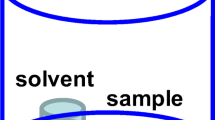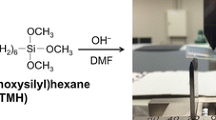Abstract
We have prepared film-forming solutions for the growth of dense and porous thin organoalkylenesiloxane (OAS) films based on copolymers of methyltrimethoxysilane and 1,2-bis(trimethoxysilyl)ethane (BTMSE) by a sol–gel process. The chemical composition and microstructure of the OAS films have been studied by IR spectroscopy and spectral ellipsometry in relation to the mole fraction of BTMSE and the water: methoxy groups ratio in solution. The results demonstrate that partial substitution of ethylene bridges for silicon–oxygen bonds in OAS leads to distortion of the regular ladder-like structure characteristic of polymethylsilsesquioxane films and the presence of residual silanol groups, which causes an increase in the dielectric permittivity k of the matrix material. The relative porosity in porous OAS films produced via evaporationinduced self-assembly has been shown to be determined by not only the amount of surfactant added but also the presence of a sufficient amount of silanol groups, participating in the attachment of surfactant molecules, in the matrix copolymer solution. In this connection, an important factor determining the structure of the OAS matrix and its pore structure is control over the amount of water involved in the cohydrolysis process. It has been shown that the samples with a relative porosity of 38% prepared from a film-forming solution containing 47 mol % BTMSE (m = 0.7) and 30 wt % surfactant have k ≈ 2.3 and are potentially attractive materials for use as insulators in integrated circuits.
Similar content being viewed by others
References
Baklanov, M.R., Ho, P.S., and Zschech, E., Advanced Interconnects for ULSI Technology, Chichester: Wiley, 2012.
Baklanov, M.R., Maex, K., and Green, M., Dielectric Films for Advanced Microelectronics, Chichester: Wiley, 2007.
Grill, A., Gates, S.M., Ryan, T.E., Nguyen, S.V., and Priyadarshini, D., Progress in the development and understanding of advanced low k and ultralow k dielectrics for very large-scale integrated interconnects—state of the art, Appl. Phys. Rev., 2014, vol. 1, no. 1, paper 011306.
Sugahara, S., Usami, K., and Matsumura, M., A proposed organic-silica film for inter-metal-dielectric application, Jpn. J. Appl. Phys., 1999, vol. 38, no. 3R, pp. 1428–1433.
Kim, B.R., Kang, J.W., and Lee, K.Y., Physical properties of low-k films based on the co-condensation of methyltrimethoxysilane with a bridged silsesquioxane, J. Mater. Sci., 2007, vol. 42, no. 12, pp. 4591–4602.
Kim, S., Toivola, Y., Cook, R.F., Char, K., Chu, S.-H., Lee, J.K., Yoon, D.Y., and Rhee, H.-W., Organosilicate spin-on glasses: I. Effect of chemical modification on mechanical properties, J. Electrochem. Soc., 2004, vol. 151, no. 3, pp. F37–F44.
Redzheb, M., Armini, S., Berger, T., Jacobs, M., Krishtab, M., Vanstreels, K., Bernstorff, S., and Van Der Voort, P., On the mechanical and electrical properties of self-assembly-based organosilicate porous films, J. Mater. Chem., 2017, vol. 5, no. 33, pp. 8599–8607.
Sanchez, C. Boissière, C., Grosso, D., Laberty, C., and Nicole, L., Design, synthesis, and properties of inorganic and hybrid thin films having periodically organized nanoporosity, Chem. Mater., 2008, vol. 20, pp. 682–737.
Comprehensive Guide for Mesoporous Materials, vol. 4: Application and Commercialization, chapter 12: Making Periodic Mesoporous Organosilicas Functional Materials, Aliofkhazraei, M., Ed., New York: Nova Science, 2015.
Kim, B.R., Son, J.M., and Ko, M.J., The effect of porogen on physical properties in MTMS–BTMSE spin-on organosilicates, J. Mater. Sci., 2007, vol. 42, no. 12, pp. 5381–5390.
Brinker, C.J., Lu, Y., Sellinger, A., and Fan, H., Evaporation-induced self-assembly: nanostructures made easy, Adv. Mater., 1999, vol. 11, no. 7, pp. 579–585.
Hatton, B.D., Landskron, K., Whitnall, W., Perovic, D.D., and Ozin, G.A., Spin-coated periodic mesoporous organosilica thin films—towards a new generation of low-dielectric-constant materials, Adv. Funct. Mater., 2005, vol. 15, no. 5, pp. 823–829.
Podgornyi, Yu.V., Seregin, D.S., and Vorotilov, K.A., Accurate permittivity measurements for thin insulator films on semiconductor substrates, Pribory, 2011, no. 7, pp. 30–39.
Nenashev, R.N., Kotova, N.M., Vishnevskii, A.S., and Vorotilov, K.A., Effect of methyltrimethoxysilane hydrolysis and condensation conditions on the proper-ties of thin polymethylsilsesquioxane films, Inorg. Mater., 2016, vol. 52, no. 6, pp. 625–629.
Toivola, Y., Kim, S., Cook, R.F., Char, K., Lee, J.-K., Yoon, D.Y., Rhee, H.-W., Kim, S.Y., and Jin, M.Y., Organosilicate spin-on glasses: II. Effect of physical modification on mechanical properties, J. Electrochem. Soc., 2004, vol. 151, no. 3, pp. F45–F53.
Grill, A. and Neumayer, D., Structure of low dielectric constant to extreme low dielectric constant SiCOH films: Fourier transform infrared spectroscopy characterization, J. Appl. Phys., 2003, vol. 94, pp. 6697–6707.
Kim, S.M., Yoon, D.Y., Nguyen, C.V., Han, J., and Jaffe, L., Experimental and theoretical study of structure–dielectric property relationships for polysilsesquioxanes, MRS Symp. Proc., 1998, vol. 511, pp. 39–47.
Jiang, T., Zhu, B., Ding, S.-J., Fan, Z., and Zhang, D.W., High-performance ultralow dielectric constant carbonbridged mesoporous organosilica films for advanced interconnects, J. Mater. Chem., 2014, vol. 2, pp. 6502–6510.
Nenashev, R.N., Kotova, N.M., Vishnevskii, A.S., and Vorotilov, K.A., Effect of the Brij 30 porogen on the properties of sol–gel derived thin polymethylsilsesquioxane films, Inorg. Mater., 2016, vol. 52, no. 9, pp. 1035–1039.
Michalak, D., Blackwell, J., Torres, J., Sengupta, A., Kreno, L., Clarke, J., and Pantuso, D., Porosity scaling strategies for low-k films, J. Mater. Res., 2015, vol. 30, no. 22, pp. 3363–3385.
Author information
Authors and Affiliations
Corresponding author
Additional information
Original Russian Text © R.N. Nenashev, A.S. Vishnevskiy, N.M. Kotova, K.A. Vorotilov, 2018, published in Neorganicheskie Materialy, 2018, Vol. 54, No. 4, pp. 423–428.
† Deceased.
Rights and permissions
About this article
Cite this article
Nenashev, R.N., Vishnevskiy, A.S., Kotova, N.M. et al. Properties of Sol–Gel Derived Thin Organoalkylenesiloxane Films. Inorg Mater 54, 405–411 (2018). https://doi.org/10.1134/S002016851804009X
Received:
Accepted:
Published:
Issue Date:
DOI: https://doi.org/10.1134/S002016851804009X




